Related Research Articles

Francesco Albani or Albano was an Italian Baroque painter who was active in Bologna (1591–1600), Rome (1600–1609), Bologna (1609), Viterbo (1609–1610), Bologna (1610), Rome (1610–1617), Bologna (1618–1660), Mantova (1621–1622), Roma (1623–1625) and Florence (1633).

The Palazzo Pallavicini-Rospigliosi is a palace in Rome, Italy. It was built by the Borghese family on the Quirinal Hill; its footprint occupies the site where the ruins of the baths of Constantine stood, whose remains still are part of the basement of the main building, the Casino dell'Aurora. Its first inhabitant was the famed art collector Cardinal Scipione Borghese, the nephew of Pope Paul V, who wanted to be housed near the large papal Palazzo Quirinale. The palace and garden of the Pallavicini-Rospigliosi were the product of the accumulated sites and were designed by Giovanni Vasanzio and Carlo Maderno in 1611–16. Scipione owned this site for less than a decade, 1610–16, and commissioned the construction and decoration of the casino and pergolata, facing the garden of Montecavallo. The Roman palace of this name should not be mistaken for the panoramic Villa Pallavicino on the shores of Lake Como in Lombardy.

The Basilica of San Domenico is one of the major churches in Bologna, Italy. The remains of Saint Dominic, founder of the Order of Preachers (Dominicans), are buried inside the exquisite shrine Arca di San Domenico, made by Nicola Pisano and his workshop, Arnolfo di Cambio and with later additions by Niccolò dell'Arca and the young Michelangelo.

The Church and Convent of the Girolamini or Gerolamini is a church and ecclesiastical complex in Naples, Italy. It is located directly across from the Cathedral of Naples on via Duomo. The facade is across the homonymous piazza and street from Santa Maria della Colonna. It is one block west of Via Duomo.

Domenico Maria Canuti was an Italian painter of the Baroque period, active mainly in Bologna and Rome. He was a major painter of fresco decorations. His ceiling decorations showed a mix of Bolognese and Roman influences.

The Palazzo Colonna is a palatial block of buildings in central Rome, Italy, at the base of the Quirinal Hill, and adjacent to the church of Santi Apostoli. It is built in part over the ruins of an old Roman serapeum, and it has belonged to the prominent Colonna family for over twenty generations.

Santa Maria della Passione is a late Renaissance-style church located in Milan, Italy.

Santi Bartolomeo e Gaetano is a Renaissance style, Roman Catholic church in central Bologna; it is located near the Due Torri adjacent to the Strada Maggiore.
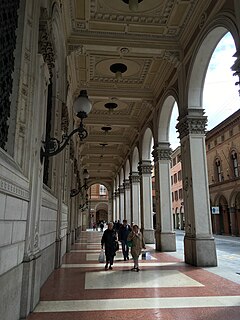
The Palazzo di Residenza della Cassa di Risparmio di Bologna is a 19th-century palace, erected as Neo-Renaissance architecture, located on Via Farini #22, Bologna, region of Emilia-Romagna, Italy. It was built and is still the headquarter of the Cassa di Risparmio in Bologna.
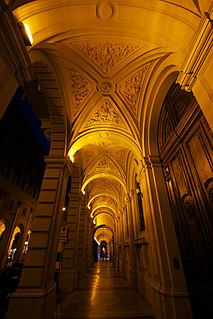
The Palazzo Legnani Pizzardi, also known as Palazzo Pizzardi e Volta or just Palazzo Pizzardi, is a Renaissance style palace located on Via d'Azeglio #38, corner with Via Farini, in central Bologna, Italy. In 2015, the palace housed the Tribunal of Bologna.

Palazzo Malvezzi Campeggi is a Renaissance palace located on Via Zamboni number 22, at the corner (southwest) with Via Marsala, in central Bologna, region of Emilia Romagna, Italy. It stands across from San Giacomo Maggiore, and just northeast of the Palazzo Magnani. It presently houses the Law Faculty of the University of Bologna.

The Palazzo Leoni Montanari is a late Baroque palace located in Contra’ San Corona number 25 in central Vicenza in the Veneto region of Italy. It now houses exhibition rooms, meeting places, and art collections owned by the bank Intesa Sanpaolo.
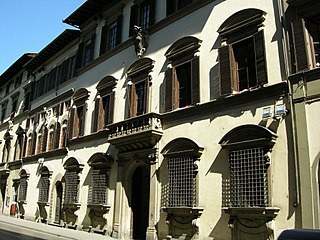
The Palazzo Capponi Covoni is a Baroque architecture palace in Florence, region of Tuscany, Italy. There are apparently three other palaces once associated with the Capponi family:
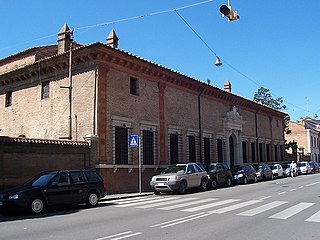
The Palazzina Marfisa d'Este is a Renaissance-style small palace, once suburban, and sometimes referred to as a villa, located on Corso Giovecca #170, just east of Central Ferrara, region of Emilia-Romagna, Italy. It was constructed in 1559 by the peripatetic Francesco d'Este, and inherited by his daughter, Marfisa in 1578.
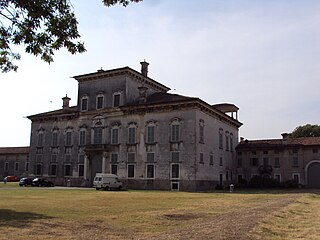
The Palazzo Lechi, or more aptly also called Villa di Conti Lechi, is a rural palace located on via del Palazzo 60 in Montirone, Province of Brescia, region of Lombardy, Italy.
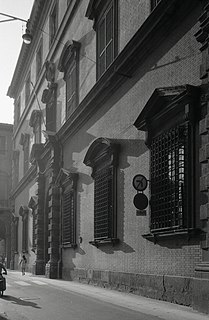
The Palazzo Caprara, also called Palazzo Galliera is a Renaissance-style urban palace located on Via IV Novembre #22 in central Bologna, region of Emilia-Romagna, Italy.
The Palazzo Zagnoni, also known as Palazzo Spada, is a Neoclassic-style palace located on Via Castiglione 25-27, in Bologna, region of Emilia-Romagna, Italy.

San Paolo Maggiore, also known as San Paolo Decollato, is a Baroque-style, Roman Catholic basilica church located on Via Carbonari #18 in Bologna, region of Emilia-Romagna, Italy.

The Palazzo Malvezzi de' Medici is a Renaissance-style palace located on Via Zamboni #13 in central Bologna, Italy. The palace now houses the offices of the Provincial Administration.
Palazzo Spalletti-Trivelli is a palace located atVia Emilia A San Pietro #2, corner with Via San Nicolò, in the center of the city of Reggio Emilia, region of Emilia Romagna, Italy. The building now belongs to the Credito Emiliano (Credem) bank, and owns the art collection now in the palace.
References
- ↑ Brochure by Bonifica Renana on Palace, entry Michele Danieli.
- ↑ Volte, Cupole, Soffitti website, entry on palace.
- ↑ Bonifica Renana.
Coordinates: 44°29′20.0″N11°21′48.05″E / 44.488889°N 11.3633472°E